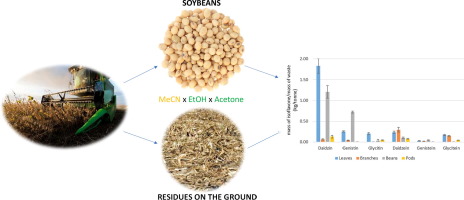Food Research International ( IF 7.0 ) Pub Date : 2019-12-26 , DOI: 10.1016/j.foodres.2019.108949 Ariadne Magalhães Carneiro 1 , Eduarda Antunes Moreira 2 , Felipe Sanchez Bragagnolo 1 , Maiara Stefanini Borges 3 , Alan Cesar Pilon 2 , Daniel Rinaldo 3 , Cristiano Soleo Funari 1

|
Soybeans are among the world’s major crops responsible for food and biodiesel production, as well as a major source of isoflavones - a class of high value-added bioactive compounds. As estimated 460 million tonnes of soya residues (branches, leaves, roots, and pods) will be produced in the 2018/2019 harvest, and 20-40% of this waste must be removed from the field to ensure soil quality and minimize environmental impacts. This work investigated the potential occurrence and content of isoflavones in soya agricultural waste collected directly from the ground after mechanically harvesting. We also assessed the extraction performances of ethanol and acetone for these materials as an alternative to acetonitrile, a problematic solvent from an environmental point of view. Considerable amounts of isoflavones were found in soya agricultural waste collected directly from the ground when compared to soybeans (2.71±0.27, 0.57±0.1, 0.30±0.05 and 2.09±0.24 kg of isoflavones/tonne of leaves, branches, pods, and soybeans, respectively). The greener ethanol and acetone performed well for a broad range of compounds. This is an example in which appreciable amounts of high value-added compounds are wasted. Since isoflavones are considered phytoestrogens, their recovery from part of this waste might avoid potential contamination of soil and groundwater.
中文翻译:

大豆农业废弃物是异黄酮的丰富来源
大豆是世界上生产粮食和生物柴油的主要作物之一,也是异黄酮(一类高附加值生物活性化合物)的主要来源。据估计,2018/2019 年收获期将产生 4.6 亿吨大豆残留物(树枝、叶子、根和豆荚),其中 20-40% 的废物必须从田间清除,以确保土壤质量并尽量减少对环境的影响。这项工作调查了机械收获后直接从地面收集的大豆农业废物中异黄酮的潜在存在和含量。我们还评估了乙醇和丙酮对这些材料的萃取性能,作为乙腈的替代品,从环境角度来看,乙腈是一种有问题的溶剂。与大豆相比,直接从地面收集的大豆农业废物中发现了大量异黄酮(每吨叶子、树枝、豆荚和大豆含有 2.71±0.27、0.57±0.1、0.30±0.05 和 2.09±0.24 千克异黄酮,分别)。更环保的乙醇和丙酮对于多种化合物都表现良好。这是一个浪费大量高附加值化合物的例子。由于异黄酮被认为是植物雌激素,因此从部分废物中回收异黄酮可能会避免对土壤和地下水的潜在污染。









































 京公网安备 11010802027423号
京公网安备 11010802027423号